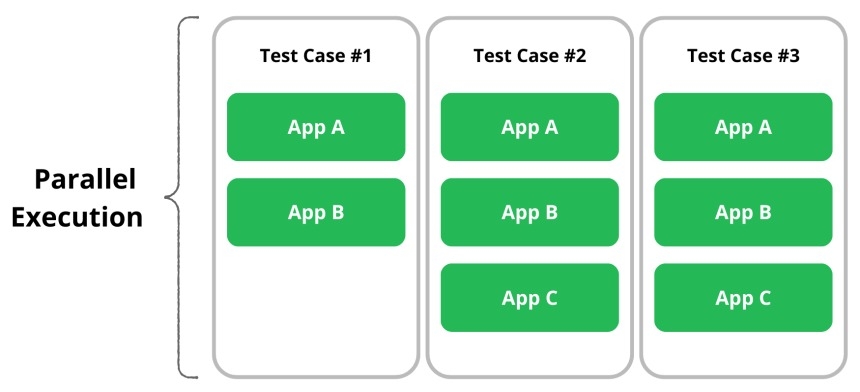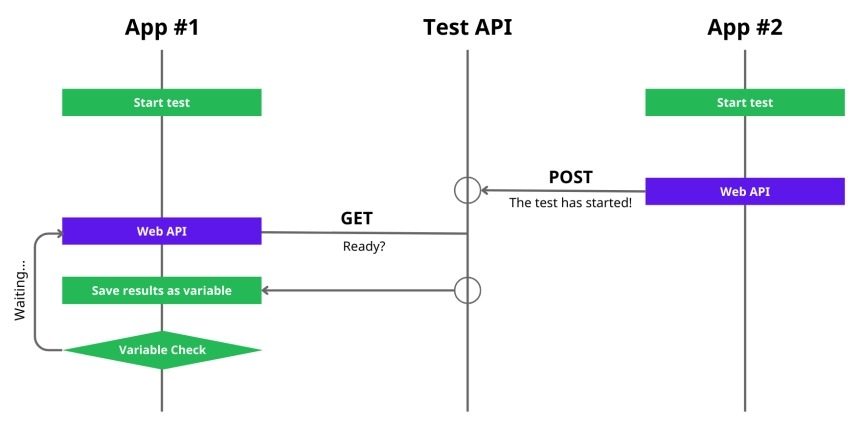Automating E2E Tests for Multiple Apps
At MagicPod, some of the teams we work with require end-to-end test automation across multiple interconnected applications. One such example is a client in the mobility & transportation industry, which needed to automate testing for their ride-hailing service, involving both a passenger app and a driver app operating in sync.
One solution is to download both the driver-side and user-side apps onto the same cloud device, and use the “Launch specified app” command to switch between apps.
However, this team chose to use three MagicPod features to achieve synchronized multi-app tests: parallel execution, waits, and web API calls. Let’s walk through this approach to understand how the team successfully automated their E2E tests using MagicPod.
Note: This article is based on a user blog post written by Yuki Matsumi, a QA engineer at GO Inc. Read his original blog post here (Japanese only).
Step 1: Using Parallel Execution for Multi-App Testing
The team needed to run both the passenger and driver apps simultaneously and validate their interaction. To do this, they used MagicPod’s parallel execution feature.
Parallel execution allows multiple test cases to run at the same time on different cloud devices. While this feature is typically used to shorten batch run execution time, this team leveraged it to operate different devices and apps simultaneously, enabling them to function as a single test scenario.

Since a single MagicPod account can only use one cloud device at a time, you will need to use two different accounts to run your tests during test creation.
Read more about parallel execution here.
Step 2: Synchronizing Test with Wait Commands
Since the two apps interact dynamically, tests needed to wait for specific actions to complete before proceeding. For example, the driver app needed to wait until a new ride request appeared before proceeding to the next steps.
The team used the “Wait Until” commands, which ensure a test waits until a particular UI element appears or a text change occurs before proceeding. This ensured synchronized execution between both apps.

Read more about wait commands here.
Step 3: Using Web API Calls for App-to-App communication
In some cases, the driver and user apps couldn’t directly detect each other’s state changes through the UI alone. To bridge this gap, the team used MagicPod’s Web API call feature, which allows MagicPod to send API requests and retrieve responses, enabling real-time app-to-app coordination. For example, the passenger app checks whether a driver has accepted a ride request by calling an API instead of waiting for UI changes.
First, they developed an API for testing purposes. This team used Google Apps Script as it allows for quick API setup without backend infrastructure, easily integrates with Google Sheets for test data management, and supports real-time parameter updates during test execution.
Then, they used MagicPod’s Web API Call command to send requests during test execution. They also used Variable commands to store API responses as variables and used them to control test flow dynamically.

Read more about Web API calls here.
Conclusion
Automating end-to-end tests across multiple apps can be challenging, especially when real-time interactions between different user roles are involved. However, by leveraging parallel execution, wait commands, and web API calls, this team successfully built a synchronized, fully automated E2E testing framework for their ride-hailing service.
Their approach serves as a great example of how teams can creatively use MagicPod’s features to tackle complex testing scenarios with efficiency and precision.


